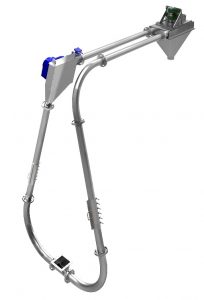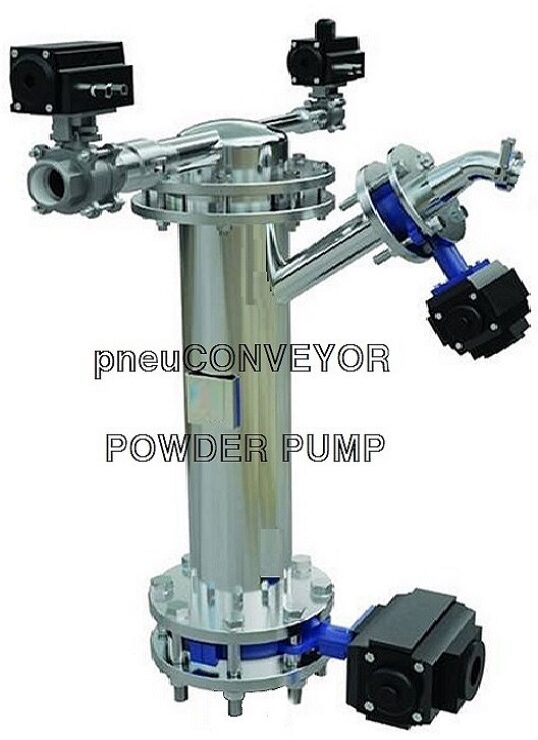pneuconveyor – tubular chain conveyor

Descriptions:- The tubular chain conveyor provides gentle, enclosed continuous transfer of bulk solid materials, including fine powders, granules, pellets, and moist sludge, at any angle, in any plane, and around any obstacle. The chain links in the conveyor’s chain-and-disc conveying mechanism function like universal joints, enabling the conveyor to simultaneously move material in multiple directions and planes. The conveyor also has a low-profile, flexible design that allows it to fit into tight spaces around existing plant equipment.
Widely used in pharmaceuticals, Chemicals, Food, Snacks, Minerals, Dyestuff, Pesticides, Fertilizers, Plastics, Pint, and other industries, the drag chain conveyor can be equipped to handle highly abrasive or hot materials also, meet sanitary requirements for transferring foods and pharmaceuticals, and safely convey potentially explosive materials all at a much lower operating cost than that of a comparable pneumatic conveyor.
Application details:- The tubular drag chain conveyor’s gentle handling makes it ideal for moving friable and other delicate materials without degradation and for transferring blended materials with minimal segregation. When properly equipped, the conveyor can handle highly abrasive or hot materials and safely transfer foods and other sanitary materials. The enclosed conveyor reliably contains dusty and hazardous materials. The enclosed design also enables the conveyor to resist internal pressure build-up caused by explosions and to contain the propagating flame, making the conveyor suitable for handling potentially explosive materials.
The tubular drag chain conveyor isn’t suitable for handling a material containing rocks larger than 1.5 inches in a vertical conveying arrangement or in a configuration with multiple turns.
- More about the components Chain- The chain can be constructed of carbon steel or stainless steel. Several chain designs are available to suit various material characteristics and operating requirements. Individual links in the chain function like universal joints, allowing the chain-and-disc assembly and the material it conveys to bend and move through multiple directions and planes.
- Discs- The discs are mounted at regular intervals along the chain by various methods and can be made of ultra-high-molecular-weight polyethylene (UHMW-PE), polyurethane, cast iron, or other materials to suit the application. The disc design can also be adapted to the application. For instance, some discs have a cost-saving split design with two semicircular halves, allowing maintenance workers to replace only the bottom (material-contact) half when the discs are worn. UHMW-PE discs for food-grade applications can be molded to stainless steel chain to form an integral part of the chain. Other discs are available in oversize diameters or with squeegee-type edges to promote full cleanout of sticky materials from the conveyor.
- Chain-tensioning mechanism- The conveyor is equipped with some type of chain- tensioning mechanism to take up slack in the chain and adjust for tension changes caused by friction, flow rate changes, variations in air and material temperatures, chain and disc wear, and other factors. Keeping the proper chain tension minimizes wear to the conveyor’s chain, discs, and housing, reducing production downtime and maintenance costs. Depending on the conveyor manufacturer, the chain-tensioning mechanism can be a manually adjusted take up located near the drive or idler assembly, or it can be an automatic device incorporated into the idler assembly, which then serves as both an idler and an automatic, continuous chain tensioned. Some take-ups and the automatic tensioning device also keep the chain in the return line under slight compression (that is, slightly loose) to facilitate cleaning material off the chain and to eliminate frictional drag on the chain’s return line, which reduces wear on the chain and discs.
Available Options:- The tubular drag chain conveyor can be operated under pressure or vacuum. To handle a potentially explosive material, the conveyor can be purged with inert gas, such as nitrogen, and it requires less inert gas for this purpose than a pneumatic conveyor of comparable size.
The conveying pipe can have an abrasion-resistant lining, such as basalt, to handle highly abrasive materials. The pipe can also be fitted with jacketing that circulates a heat exchanging fluid to cool hot materials during conveying.
The conveyor can be designed for frequent wash down in clean-in-place applications, such as transferring foods and pharmaceuticals, with components such as quick-disconnect joints, FDA-approved Teflon / UHMW-PE discs molded directly to a stainless steel chain, and stainless steel sprockets or other rotating mechanisms. Various clean-in-place components and drying-air supply systems to minimize cleaning downtime and labor.

